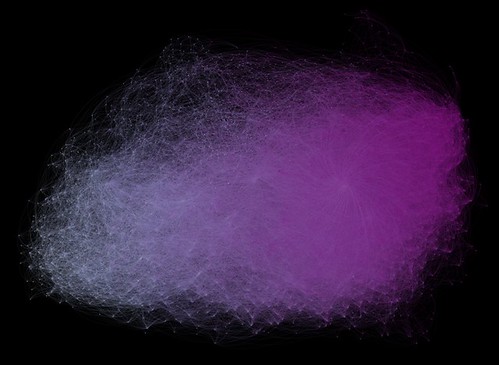Saturday, December 31, 2016
The Fake Academy: Scholarly Open Access
Like many scholars I get a fair number of solicitations from dodgy-sounding journals and conferences. The New York Times has an article about the phenomenon, A Peek Inside the Strange World of Fake Academia by Kevin Cary. Cary mentions a list of dodgy journals and publishers by Jeffrey Beall: Scholarly Open Access.
Cary looked into the World Conference on Special Needs Education (W.C.S.N.E) and found "the story was more complex than I expected." The paper submission guidelines seemed tailored to jamming a large number of papers into a single publication and, when contacted, many “Program Committee members” and “Keynote Speakers” where unaware of the affiliation with W.C.S.N.E. So:
Richard Cooper, the director of disability services at Harcum College, a private two-year institution in Philadelphia, helped create W.C.S.N.E. along with Mr. Shoniregun. He says he has no involvement with the paper selection process or financial aspects of the conference, simply serving as an organizer, presenter and master of ceremonies. He described it as a worthwhile gathering of scholars, many of whom live in Africa and India and pay hundreds of dollars in conference fees to attend.The papers presented at previous W.C.S.N.E. conferences don’t appear to have been composed using the autocomplete function on an iPhone. They mostly describe small qualitative studies and surveys that examine well-established ideas, break little new ground and use statistical jargon to make their findings seem more complicated than they really are. They very likely would be rejected by the American Educational Research Association. But they are also well within the bounds of what gets published in many scholarly journals that, while not prestigious, have never been called a fraud.
Cary concludes:
There are real, prestigious journals and conferences in higher education that enforce and defend the highest standards of scholarship. But there are also many more Ph.D.-holders than there is space in those publications, and those people are all in different ways subject to the “publish or perish” system of professional advancement. The academic journal-and-conference system is subject to no real outside oversight. Standards are whatever the scholars involved say they are.So it’s not surprising that some academics have chosen to give one another permission to accumulate publication credits on their C.V.’s and spend some of the departmental travel budget on short holidays. Nor is it surprising that some canny operators have now realized that when standards are loose to begin with, there are healthy profits to be made in the gray areas of academe.
Friday, December 30, 2016
Freud on dreams, perhaps he was right
In my undergraduate days in the 1960s Freudian thought was still more or less acceptable, if not necessarily in academic psychology departments. Since then, however, the criticism has been piling up – though I still hold out hope, as in this post, Neural Weather, an Informal Defense of Psychoanalytic Ideas. Josie Malinowski reports some recent work that supports Freud's idea "that we dream of things we are trying our best to ignore."
The late Daniel Wegner
noticed that when we are trying hard to ignore or suppress a thought, it often just keeps coming back.He suggested that this is because we have two psychological processes at work at the same time when we try to suppress a thought: an operating process that actively suppresses it, and a monitoring process that keeps an eye out for the suppressed thought. Thought suppression is therefore complicated and can only be achieved when the two processes are working together harmoniously.
In 2004 he tested this idea in 2004:
In his experiment, participants were asked to identify a person they knew and then to spend five minutes writing a stream-of-consciousness (about whatever came to mind) before going to bed that night.The first group of these participants were told specifically not to think about the person during their five minutes of writing, whereas a second group were told to specifically think about them. A third group could think about whatever they wanted. When they woke up in the morning, they all recorded any dreams they could remember having that night.The results were clear: the participants who were instructed to suppress thoughts of a person dreamt of them much more than the participants who were instructed to focus their thoughts on the person and the participants who could think about whatever they wanted. Wegner called this the “dream rebound effect”.
Malinowski goes on to report other experiments as well. The article has a dozen or so useful links to the technical literature.
Terry Teachout appreciates Harry James
The Harry James Orchestra with Frank Sinatra, July 8, 1939. Sintra opens, but James closes with a solid Armstrong-influenced solo starting at 2:44. Listen to his stop-time chorus at 3:05 and the following descending cascades.
Why, then, is James mostly forgotten? First, his popularity was and is off-putting to certain critics and jazz buffs, and the way in which he won it was even more offensive to them. As John S. Wilson explained in the Times obituary, James’s success “came only when he added to his repertory romantic ballads played with warm emotion and a vibrato so broad that at times it seemed almost comic.” Still, even at the height of his commercial success, he also played plenty of hard-core big-band jazz, and numerous other critics and scholars, including some who had no use for his schmaltzy hit records of “I Don’t Want to Walk Without You” and “You Made Me Love You,” lauded him. Gunther Schuller, for one, called James “the most technically assured and prodigiously talented white trumpet player of the late Swing Era…possibly the most complete trumpet player who ever lived.”No less troublesome, especially now that race-conscious jazz critics are on the lookout for egregious examples of “cultural appropriation,” was the fact that James was white. But the color of his skin did not prevent such illustrious black trumpeters as Miles Davis, Dizzy Gillespie, and Clark Terry from admiring his technique and artistry. Louis Armstrong, on whom James initially modeled his playing, went so far as to praise him in characteristically pithy terms: “That white boy—he plays like a jig!”
He could play the blues:
James had another spear in his capacious quiver. Like Armstrong, he was also a wholly idiomatic blues player, an accomplishment rare among white jazzmen of the ’30s that added emotional depth to a self-consciously flashy style. As he explained in a 1977 interview with Merv Griffin: “I was brought up in Texas with the blues. When I was 11 or 12 years old, down in what they call Barbecue Row, I used to sit in with the guys that had the broken bottlenecks on their guitars, playing the blues. That’s all we knew.”
But he never really sold himself to the public as a jazz soloist. He was always the band leader:
Throughout his two-year tenure as a member of Benny Goodman’s troupe, he had recorded to unfailingly powerful effect as a small-group sideman with such distinguished swing-era contemporaries as Lionel Hampton, Billie Holiday, Pete Johnson, and Red Norvo. But after he started his own band in 1939, James never again worked as anything other than a leader, nor did he perform in small groups save on rare occasions with studio-only combos whose members were drawn from the ranks of his own band. As a result, baby-boom jazz fans were largely unaware of his gifts as an improviser.
It's hard to describe what's going on here, but it's obviously from a movie (Do You Love Me? 1946). The introduction is silly and pretentious, but James shows his blues chops at 0:33. From there to the end it's up and down, and James is always so down he's up. Or is it so up he's down?
* * * * *
James did the off-screen trumpet playing for Kirk Douglas in Young Man with a Horn (1951). I still remember watching that movie on TV sometime in the early 1960s. It electrified me (figuratively speaking). Some commentary on the racial politics of the film HERE.
Thursday, December 29, 2016
The Faith of Graffiti, Redux
I originally posted this review in 2010. But the book is an important one, so I'm bumping the review to the top of the queue.
* * * * *
Norman Mailer and Jon Naar. The Faith of Graffiti, New Edition. It Books, 2009.
Conceived by designer Mervyn Kurlansky, executed by Jon Naar (photographer) and Norman Mailer (writer), and named by CAY 161 (writer), The Faith of Graffiti hit like a bomb when it was first published in the Spring of 1974. Graffiti was still young, hip-hop didn’t exist, and the war in Vietnam was still taking lives. Faith got a full page in the New York Times Book Review, helped, no doubt, by Mailer’s name on the jacket. But Mailer’s remarkable essay wouldn’t have meant jack if its hopes and claims weren’t supported and amplified by Jon Naar’s powerful photographs.
One can’t have an art book without photographs of the art, but Naar’s photographs are more than that. For he’s not photographing self-contained works framed to be hung on walls. The names he’s photographing – for that’s what graffiti is, names, variously written, embellished, tricked out, disguised, and transformed – do not imply natural boundaries. They’re written directly on walls, then in New York City — though Philly's Cornbread was up first. Wherever arms could reach, names followed. (You can see some of these photos at Naar’s website.)
Here’s the wall of a paddleball court: COMET, BABY 183, Bingo, STiTch I, KEY II, FAST ED, PiE, Barbara 62 — 10s and 100s of names, a community of names, on this one wall. Naar has framed this shot by two paddleball players, backs to us. Then there’s FRANK 136 in large white letters on the surface of a playground, a girl skipping across at the upper right, two boys and a basketball, upper middle, and a name-laden wall across the top edge, those names showing the beginnings of the elaborations that would become pieces, aka masterpieces. Elsewhere: MARiA I, FRANNY, and CHETTA in bright red, TooTs and Sissy in blue and red, and others, all on a deep green background, flecked here and there with yellow. What about three TUROK 161’s, two FRANK 207’s (plus three stars and a crown), all on the red side of a subway car. Or: “Rube” in bright red followed by an “N” just scratched on a metal surface – RubeN – with four tic-tac-toe games to the lower left.
In many photos the city and the people take up more space than the graffiti, thus placing the graffiti in the life of the city. Where it is / was / belongs. Yes, the subway cars (inside as well as out) and platforms and stations, but also the steps and stoops, apartment houses, trees, statues, parks, fences, bridges, underpasses, shacks and sheds – the fixed and mobile infrastructure of the city. Some of the writers posed for Naar, he got some action shots too, and there’s a blurred photo of some police cornering some writers. In many shots we see people just going about their business on the streets, on buses, and in the subways.
And light playing about all of this.
Naar had to figure out how to SEE this, what to see, how to frame it, what’s there, what’s only implied. If you’ve done much photography with serious intent you know that, no matter how deliberate you may be about a given shot, you don’t know what you’ve got until you’ve taken your work out of the camera. And when Naar took these photos, he was often challenged in the deliberation department — 3000 shots in two weeks, and some of that time running from police. There is thus a sense in which Naar didn’t know what he was doing when he took these photos, and he did it very well indeed.
A lesser photographer would have blown the assignment, and Mailer would have had nothing to justify what he wrote, though the graffiti would still have been there, in the streets.
Wednesday, December 28, 2016
Nigeria Rock Special: Psychedelic Afro-Rock & Jazz Funk in 1970s Nigeria
I posted this very soon after I started listening to it, quite possibly even before I'd finished the first cut. I've now listened to the whole thing. It's wonderful, infectious, funky music. And yes, I can hear the psychedelic in it too, whether from P-Funk or Vanilla Fudge. I couldn't keep still while listening.
Can reviewer anonymity weaken the value of a reviewer’s comments?
Some more crude thoughts in the course of mulling over my rejection at NLH.
A week ago I’d posted, On Discussion and Debate in the Blogosphere, in which I pointed out that when people comment under pseudonyms it can be difficult to interpret their remarks, and this is especially because such discussion is informal and most remarks are made relatively quickly. One and the same remark has one valence if made by someone who is expert in the topic at hand and a different valence if made by someone who is a neophyte.
The same is true of the anonymous reviews one (sometimes) receives on articles submitted for formal publication. That is certainly the case with my recent rejection at New Literary History. I’d submitted an article, Sharing Experience: Computation, Form, and Meaning in the Work of Literature, where I argued that the concept of computation could help us understand the nature of literary form. The reviewer was quite critical of my treatment of computation. Since, however, I do not know who the reviewer is, I don’t have any sense of what they know about computation. In particular, what do they know of computational linguistics and the computational study of story telling, the computational disciplines most germane to my argument? How can I evaluate their comments if I know nothing of their background in computing?
Here’s the reviewer’s comments about computing. Since I am taking these out of context, that may weaken your ability to evaluate them, but I’m not asking you to make any subtle judgment.
Why is it advantageous to use the conception of computation to think about literary processes? How does such a move speak to current debates in literary studies? How might one respond to those skeptical of the spread of computational metaphors through the culture at large? There is, moreover, a long history of conceiving the mind as akin to a machine/calculator/computer that deserves at least brief acknowledgment. [...] The essay repeatedly declares the importance of computational models, but fails to makes its case through a sustained argument.
If the reviewer has some familiarity with computing, then these are serious criticisms indeed. But if the reviewer is uninformed, as I fear most humanists are, then they are still serious, but with rather a different valence.
If the reviewer is unsophisticated how can they judge whether or not the essay addresses “current debates in literary studies”? I wouldn’t have written the piece if I didn’t think it contributed to current debates and if I didn’t indicate just how in my article – form, intersubjectivity (aka sharing). An unsophisticated reviewer, however, might not see that, as they’d find my discussion rather opaque. If the reviewer is sophisticated, though, they might be saying that my article fails on computational terms; the question of whether or not it speaks to literary issues is thus irrelevant.
I know perfectly well that literary critics are relatively uninformed about computational linguistics – that’s my default assumption; digital criticism aside, I see very little computational sophistication in literary criticism [1]. That’s one reason I wrote the article, to show how computation IS relevant. The fact that this reviewer rejected the article means that, on the face of it, I failed to make my case.
Perhaps though I could not possibly have succeeded. What if the reviewer is not only unsophisticated, but also ideologically opposed to computation in the study of the human mind, which is not necessarily the default value? It is quite possible that there is no argument I could make that would have convinced this reviewer.
I’m caught in an impossible inferential circle. The only evidence I have of the reviewer’s computational sophistication is in their remarks. But I can’t make sense of their remarks unless I know something else about their computational sophistication.
Tuesday, December 27, 2016
Tales of the Web: On not being able to log-on to a familiar site, or, greased electrons in Philadelphia?
The web cracks me up. It’s so strange.
For several years now I’ve been a regular contributor to Replicated Typo, a group blog devoted to linguistic and cultural evolution. Several weeks ago I found myself unable to access the site. I kept getting an error message: “Safari can’t open the page www.replicatedtypo.com because the server where this page is located isn’t responding.” Well, this sort of thing has happened before.
I tried accessing it with another browser, Firefox and then Chrome. No dice. But the Firefox error message is more helpful: “The server at www.replicatedtypo.com is taking too long to respond.” I flushed the browser cache (all of them) of Replicated Typo cookies. Still no dice.
So, just before Christmas, I got on Facebook to chat with James Winters, the site founder. We quickly determined that the problem seemed exclusive to me.
Saturday morning, December 24, I travel to Philadelphia to visit my sister, taking my laptop with me. And then, either later on Saturday or, more likely, Sunday morning (I forget exactly) I got online and, wouldn’t you know, I was able to access Replicated Typo. Yippie! But why?
Who knows?
Anyhow, I made to posts to RT and exchanged comments about them. I returned to Jersey City yesterday afternoon (December 26), hooked up my laptop, and gave it a whirl. Guess what? I was able log-on to RT.
But, again, why? Did Philadelphia have some greasy electrons that flushed some buffers on my machine? Sure, that’s nonsense, but then this whole story is nonsense. Yet if that were the case, why’d my sticky electrons affect RT and none of the other of the websites I use? And maybe it's because my sister has a different internet provider than I do.
Who knows?
But I was happy to be able to log-on to RT. And it saved me from Plan B, which was to go to the Starbucks around the corner and see if I could log-on through their Wi-Fi.
Now that things were back to normal I figured I’d write a post about this incident. It would be a quick and easy cheap post to help hold things down while I’m thinking about OTHER STUFF. Just to be sure I was up and running before writing this post, I decided to confirm that things are back to normal for me at RT.
Guess what? No go. Not on Safire, not on Firefox, not on Chrome.
Rats!
Am I really going to have to try Starbucks? Is there a way I can get an infusion of those Philly electrons up here in Jersey? Will Trump be able to fix this problem with a magical tweet?
Who knows?
Addendum, 31 December 2016: I can now access the site. Will I be able to access it tomorrow, or the next day? who knows?
Addendum, 31 December 2016: I can now access the site. Will I be able to access it tomorrow, or the next day? who knows?
Monday, December 26, 2016
Time is Tricky: Looking Back at Looking Forward in Literary Criticism
Some crude thoughts in the course of mulling over my rejection at NLH. I’ve said most of this before, though not quite in this form.
Time is tricky. When I shuffled off to Buffalo in 1973 I thought I was going to get the training and credential, Ph.D. in English, that would allow me to enter the profession. I realize in retrospect, though, that by that time I had already left the profession intellectually. No one realized that at the time, not me, but not the people I studied with in the English Department at Buffalo. Yes, it was obvious that my interests were quite outside the mainstream. The department at Buffalo was deliberately conceived as an experimental one and encouraged work that was outside the mainstream. But my work, it was outside the ‘envelope’ at Buffalo.
It’s clear that my work with David Hays in linguistics was the center of my studies at Buffalo. Of course the English Department knew of this and approved. It was while at Buffalo that I published my cognitive networks article in MLN. That article was full of technical diagrams and well-night unintelligible to humanists. My 1978 dissertation, “Cognitive Science and Literary Theory”, was similar. The department awarded me a degree for it, but I doubt that anyone understood it.
When, then, grant me a degree? For one thing, their colleague in linguistics, David Hays, signed off on it. For another they had faith in me. Perhaps they were open and optimistic about the future of the profession; that’s what the department was for, no?
I have trouble imagining any English department today awarding a degree for the dissertation that I wrote back then. Back then no one was working on cognitive science and literature. Now it is a recognized, if minor, specialty. But that 1978 dissertation is very different from current work in literary cognition. Contemporary literary cognitivists haven’t looked at computation, and the don’t do the kind of thinking that requires diagrams (or formal expressions). The technical content of that old dissertation would make it a tough slog for contemporary literary cognitivists.
Back then – the 1970s – the profession was open and looking ahead. That’s not true today, at least not in the same spirit. A lot of people know that things have to change. But I don’t see a lot of people looking for new things. People are just drifting. But, and here’s the tricky part, it is clear in retrospect that it was during those same optimistic 1970s that the profession opted for the course that now seems cramped and closed. Though I don’t think this is quite the right formulation, the profession rejected any mode of thought that required non-discursive thinking. That means the “technical structuralism” that bothered Geoffrey Hartman.
But it also means – and this linkage is new to this story – the kind of formal analysis that Mark Rose employed in Shakespearean Design (1972). For that required him to use diagrams, simple diagrams that are nothing like the complicated cognitive diagrams that I use, and he was apologetic about that. As far as I can tell (I hope I'm wrong) that study has been without substantial intellectual issue until James E. Ryan's, Shakespeare’s Symmetries: The Mirrored Structure of Action in the Plays (McFarland 2016).
But it also means – and this linkage is new to this story – the kind of formal analysis that Mark Rose employed in Shakespearean Design (1972). For that required him to use diagrams, simple diagrams that are nothing like the complicated cognitive diagrams that I use, and he was apologetic about that. As far as I can tell (I hope I'm wrong) that study has been without substantial intellectual issue until James E. Ryan's, Shakespeare’s Symmetries: The Mirrored Structure of Action in the Plays (McFarland 2016).
Digital criticism is the major exception. As far as I can tell this is the only arena in literary studies where non-discursive modes of thinking are important. Who knows where that will lead. Maybe it will lead literary criticism to open up. But it might also lead to a split where the digital critics form their own departments – they already have their own conferences and journals (like other specialties). We’ll see.
Sunday, December 25, 2016
How Trump runs his business
When Tiah Joo Kim arrived at the Manhattan headquarters of the Trump Organization to pitch a hotel and condominium project in Vancouver, British Columbia, he expected the famous company with ventures across the globe to come with capacious offices and a staff of hundreds. Instead, he was led through a mere two floors with what appeared to be no more than a few dozen employees. “Lean,” Mr. Tiah, a young Malaysian developer, remembers thinking as he walked the halls.The first stop was a conference room, where Mr. Tiah was required to sell his vision to the boss’s three oldest children. Only after securing their support did he advance to the inner sanctum, with its sweeping views of Central Park.Mr. Tiah was not sure what to expect from the man whose face was beamed around the world through the reality television show “The Apprentice,” but the conversation that afternoon in 2012 was casual and warm. Donald J. Trump spent more time showing off a Shaquille O’Neal shoe and a Mike Tyson championship belt — prize artifacts from his display of sports memorabilia — than interrogating Mr. Tiah on the details of his business plan. “You’re a good-looking guy,” Mr. Tiah recalled Mr. Trump telling him as he gave the project his blessing.Then Mr. Trump’s trusted lawyers and other top executives swooped in to play hardball — working alongside Donald Trump Jr. to negotiate the confidential agreements that would allow the Vancouver development to be branded with Mr. Trump’s name and managed by his company. The talks consumed 16-hour days for nearly a week, Mr. Tiah said, explaining: “It was tiring. They’re tough.” ...His company is a distinctly family business fortified with longtime loyalists that operates less on standardized procedures and more on a culture of Trump. Mr. Trump may leave the details of contracts to his deputies, but his name — and influence — is stamped on every deal the company does.In an interview last spring with The Times, Mr. Trump explained that he approved new ventures based on his personal “feel.” And while in recent years his three oldest children have taken on more of a leadership role, Mr. Trump has the final say, sometimes weighing in on the most minute design details of planned hotels, golf courses or other properties the company owns or manages.
This makes sense to me. It's what I would have expected given what we've seen of him during the election and in the transition (so far). But can he run the government that way? The man's style is the man's style and I assume he'll do his best to mold the White House to that style – what else could he do?
That description suggests that his subordinates are extraordinarily important, as they're the one to take care of details. But surely at THAT abstract level of description that describes any role at the top of a large organization, and the US Federal Government is a very large organization. Any president is going rely on subordinates.
Trump's business, by his own favored characterization, is a business of deals. His subordinates vet the details and he makes the decision based on his "feel" for his counter party, like Mr. Tiah. How does that translate into government business? Who is the counter party for a piece of legislation, a treaty, or policy in general? Who's the person Trump schmoozes with to make the yes or no decision?
Have yourself a merry little Christmas, It may be your last...
Though it's Christmas Day – and I'm visiting in my sister in Philadelphia, as I've been doing for the last umpteen years – as the title suggests, this post is not full of Christmas cheer. I'm reading a NYTimes op ed by Bruce Murphy, who has chosen to write about a song we've heard countless times in shopping malls, those that remain, elevators, and Starbucks. It's about a song whose familiar lyrics start like this:
Have yourself a merry little ChristmasLet your heart be lightNext year all our troubles will be out of sight
The original lyrics are quite different:
Have yourself a merry little ChristmasIt may be your lastNext year we may all be living in the past
The song debuted on Meet Me in St. Louis in 1944, where it was sung by Judy Garland, who sang the familiar lyrics, not the original ones. It's about a St. Louis family whose lives are about to be disrupted because Daddy got a promotion that will take them to New York. The girls are distraught that their lives are about to be turned topsy-turvy. So the original lyrics are quite appropriate to the situation. But the producers wouldn't buy it, and neither did Garland. So the lyrics were changed.
Murphy had just heard the original lyrics at a concert, was moved by them, and thought them appropriate to our current national situation. Though he never mentioned the election of Sir Little Hands of the Bad Hair Day as President, that must have been one of the things he had in mind. So, in honor of Lord Bling Bling of the Rattling Sabres I give you a third version:
Have yourself a merry little Trump DayIt will be a blastNext year our atoms will join the clouds...
BTW, Meet Me in St. Louis had a happy ending, Murphy informs us (I've not seen it); Daddy turned down the promotion so the kids could stay in St. Louis with their friends. Alas, I fear the Count Grabby Hands intends to promote the Hell out of his election.
Saturday, December 24, 2016
More Rambling (on a Saturday Morning) [Ramble 4]
I normally take a shower every other morning. I lead a sedentary life and really, there’s no need to shower every day. But I made an exception this morning (I’d showered yesterday). I’m going to visit my sister in Philadelphia and figured I ought to be clean and smooth-shaven.
Glad I took the shower. Showers are good for thinking. Baths, long baths, mind you, are better. By I don’t have a tub, so showers it is.
Review the Journals and their Reviewers
As I indicated the other day, my article was turned down for publication at New Literary History. I’m still mulling that over, working a blog post – which has been growing and growing – and perhaps two or three posts. We’ll see.
One thought I had is that we need a more or less public way to evaluate journals. Here I’m thinking not so much about quality – these days we’ve got impact factors, which is public enough; and journals have reputations – but about how they treat authors and prospective authors. NHL promises a 4-month decision on your submission; which is very good (I believe) for humanities journals. I got my decision in two and a half months. That’s very good indeed, even if it’s not the decision I wanted.
But I’ve got a bad taste in my mouth about the reviewer’s report. It’s clear that he or she really didn’t understand what I was up to and was not sympathetic to it. I just wish the reviewer would have owned up to it, perhaps by saying something like this:
I don’t really understand what’s going on in this essay. The author is arguing for things that seem obvious and is using strange diagrams that don’t make any sense to me. And computation!? If it doesn’t make sense to me, it’s not likely to make sense to readers of NLH.
THAT makes sense to me. I don’t like it; it’s not what I wanted to hear. But I understand and have little trouble accepting rejection on those grounds.
But the reviewer acted as though he or she was perfectly competent to evaluate my work and that much of what I did was of little apparent value. THAT bothers me, and as a consequence I don’t know quite what to do with the reviewer’s comments.
I know, of course, that my work does present problems for literary journals. Like all scholars they’re used to evaluating work of a familiar kind. Most pieces submitted to NLH, or any other journal, aren’t going to present that kind of problem. For all I know, NLH is exemplary in the reviews it gives to authors – and, given its prominence in the field, most of those authors will be rejected. And perhaps most of the rejected authors have found useful advice in the reviewer’s report.
If so, then there ought to be a public forum where that information can be available. Just how that would work, I don’t know. But we’ve certainly got the technology to do it.
Three Kinds of Writing
Another thought I had was that I do three levels of writing: Private, Informal, Formal. Private is just that, for me only. Sometimes it’s just words and phrases and references. And sometimes it may be a whole run of more or less coherent paragraphs, but still, intended for no one but me.
Informal writing is what I put on blogs, mostly here and New Savanna, but a one or two other places as well. This work is intended to be read by others. For the most part I write in whole sentences. These pieces range from less than 100 words to several thousand.
Some of these can be intellectually intense, but, still, they’re informal. These are the posts I collect into working papers.
I’d say that my posts at 3 Quarks Daily ride the borderline between informal and formal. They aren’t so long, closely argued, or heavily cited as my New Savanna Blog posts, but I do work on them a bit more.
Formal writing is just that, writing intended for formal academic publication. These pieces are long, 5000 to 25,000 words or more, and are intended to be published in academic journals. They’re densely argued and have lots of citations.
And then there’s everything else.
My posts at 3 Quarks Daily
Listed in order started from the most recent.
To boldly go to the Edge....science in everyday life
Prelude and Exordium to the Ordination, Coronation, Inauguration, and Installation of the Grand High Singularity, Donald of Trump, Ruler of Universes Known, Unknown, Unimaginable and Phantasmagoric
Exposed! Daniel Everett Shines a Light on the Mind’s Dark Matter
We’re All in This Together: Life as Jamie Knows It
Martha Mills: Lawyer, Activist, Judge
Markos Vamvakaris: A Pilgrim on Ancient Byzantine Roads
Peace is Everybody’s Business, Nobody’s Job
A Brexit State of Mind: The Vision Thing
Grandpa, Proust, Ulysses and World War II
Ecstasy at Baltimore’s Left Bank Jazz Society
Break! How I Busted Three Trumpeters Out of a Maryland Prison
Jerry Seinfeld and Barack Obama Have a Meeting of the Minds
Three Moments in America’s Conversation on Race
Secrets of Pink Elephants Revealed
The United States Needs a Department of Peace
Why Miyazaki’s The Wind Rises is Not Morally Repugnant
Have the Internets Rotted My Brain and Wrecked My Mind?
Robert Frost, Time Traveler: The Road Not Taken
A White Blackman
Obama’s Pinckney Eulogy and the Place of Religious Discourse in Civic Life
Pontifex as Bridge Builder: the Encyclical Laudato Si (by Charles Cameron)
The Next 100 Years in the Human Sciences, a Reply to Frank Wilczek's Remarks about Physics
OK to Destroy: Jersey City's Graffiti Jam of April 2015
The Magic of the Bell and a Glimpse of Spirits
Cultural Styles in the 21st Century, or the High Tech Debt to Africa
Charlie Keil's Simple Appeal to the Pope on Behalf of the Future (by Charlie Keil)
Western Culture is an Ideological Fiction, and so are the Rest
Free-Floating Anxiety, Teens and Security Theatre
American Craziness: Where it Came from and Why it Won't Work Anymore
Evolving to the Future, the Web of Culture
Macroanalysis and the Directional Evolution of Nineteenth Century English-Language Novels
It's Time to Change the World, Again
Sing Me a Song of Hyperobjects: Starting Over with Humans and Other Creatures in the 21st Century CE
Graffiti is the Most Important Art Form of the Last Half-Century...
Graffiti and the Spirit of the Place
The Only Game in Town: Digital Criticism Comes of Age
Bundling, Dream Space, Love and the Farmer's Daughter
Some Varieties of Musical Experience
An Astonishing Tale about the Origins of Golf: A True Story
Charlie Keil: Groovologist
Two Problems for the Human Sciences, and Two Metaphors
To boldly go to the Edge....science in everyday life
Prelude and Exordium to the Ordination, Coronation, Inauguration, and Installation of the Grand High Singularity, Donald of Trump, Ruler of Universes Known, Unknown, Unimaginable and Phantasmagoric
Exposed! Daniel Everett Shines a Light on the Mind’s Dark Matter
We’re All in This Together: Life as Jamie Knows It
Martha Mills: Lawyer, Activist, Judge
Markos Vamvakaris: A Pilgrim on Ancient Byzantine Roads
Peace is Everybody’s Business, Nobody’s Job
A Brexit State of Mind: The Vision Thing
Grandpa, Proust, Ulysses and World War II
Ecstasy at Baltimore’s Left Bank Jazz Society
Break! How I Busted Three Trumpeters Out of a Maryland Prison
Jerry Seinfeld and Barack Obama Have a Meeting of the Minds
Three Moments in America’s Conversation on Race
Secrets of Pink Elephants Revealed
The United States Needs a Department of Peace
Why Miyazaki’s The Wind Rises is Not Morally Repugnant
Have the Internets Rotted My Brain and Wrecked My Mind?
Robert Frost, Time Traveler: The Road Not Taken
A White Blackman
Obama’s Pinckney Eulogy and the Place of Religious Discourse in Civic Life
Pontifex as Bridge Builder: the Encyclical Laudato Si (by Charles Cameron)
The Next 100 Years in the Human Sciences, a Reply to Frank Wilczek's Remarks about Physics
OK to Destroy: Jersey City's Graffiti Jam of April 2015
The Magic of the Bell and a Glimpse of Spirits
Cultural Styles in the 21st Century, or the High Tech Debt to Africa
Charlie Keil's Simple Appeal to the Pope on Behalf of the Future (by Charlie Keil)
Western Culture is an Ideological Fiction, and so are the Rest
Free-Floating Anxiety, Teens and Security Theatre
American Craziness: Where it Came from and Why it Won't Work Anymore
Evolving to the Future, the Web of Culture
Macroanalysis and the Directional Evolution of Nineteenth Century English-Language Novels
It's Time to Change the World, Again
Sing Me a Song of Hyperobjects: Starting Over with Humans and Other Creatures in the 21st Century CE
Graffiti is the Most Important Art Form of the Last Half-Century...
Graffiti and the Spirit of the Place
The Only Game in Town: Digital Criticism Comes of Age
Bundling, Dream Space, Love and the Farmer's Daughter
Some Varieties of Musical Experience
An Astonishing Tale about the Origins of Golf: A True Story
Charlie Keil: Groovologist
Two Problems for the Human Sciences, and Two Metaphors
Friday, December 23, 2016
Mutable stability in the transmission of medieval texts
I've just checked in at Academica.edu and was alerted to this article:
Stephen G. Nichols, Mutable Stability, a Medieval Paradox: The Case of Le Roman de la Rose, Queste 23 (2016) 2, pp. 71-103.
I've not yet read it, but a quick skim makes it clear that it speaks to a current debate in cultural evolution concerning the high-fidelity transmission of "memes" (Dan Dennett) vs. the variable transmission of objects as guided by "factors of attraction" (Dan Sperber). I've not yet read it, but here's some tell-tale passages. This is from the beginning (p. 71):
Yet even those who argue, to the contrary, that ‘transmission errors’ often represent creative ‘participation’ by a talented scribe, must recognize the attraction of a stable work.After all, despite an extraordinary record of innovation, invention, and discovery, the Middle Ages are an era that resisted change in and for itself. And yet this same veneration of conservative values underlies a fascinating paradox of medieval culture: its delicate and seemingly contradictory balance between stability, on the one hand, and transformation, on the other. It may be that only an era that saw no contradiction in promulgating an omnipotent, unchanging divinity, which was at the same time a dynamic principle of construction and transformation, could have managed the paradox of what I want to call ‘mutable stability’.
Here's Dawkins in the 2nd chapter of The Selfish Gene:
Darwin’s ‘survival of the fittest’ is really a special case of a more general law of survival of the stable. The universe is populated by stable things. A stable thing is a collection of atoms that is permanent enough or common enough to deserve a name. It may be a unique collection of atoms, such as the Matterhorn, that lasts long enough to be worth naming. Or it may be a class of entities, such as rain drops, that come into existence at a sufficiently high rate to deserve a collective name, even if any one of them is short-lived. The things that we see around us, and which we think of as needing explanation–rocks, galaxies, ocean waves–are all, to a greater or lesser extent, stable patterns of atoms.
Etc.
Back to Nichols, a bit later in the article (p. 77):
In this case, however, it’s one that allows us to understand the paradox of medieval narrative forms whose ‘stability’ over time – in some cases over several centuries – depends on what I call the generative – or regenerative – force of transmission. Why ‘regenerative’ if transmission involves reproducing the ‘same’ work from one representation to another? The answer to that question involves recognizing the complex forces at play in the transmission of me- dieval texts, beginning with concepts like ‘the same’ and ‘seeing’ or ‘perspective’. After all, in a culture where the technology of transmission depends on copying each text by hand, what the scribe sees, or thinks she or he sees, must be factored into our definition of ‘sameness’ when comparing original and copy.In the event, ‘sameness’, for the medieval mind had a very different connotation from our modern senses of the term. Indeed, it even involves a different process of perception and imagination. Whereas in our age of mechanical and digital reproduction, we are used to standards of ‘exactness’ for things we recognize as identical, me- dieval people had neither the means nor the expectation to make ‘same’ and ‘exact imitation’ synonymous. Indeed, one may even question the existence at that time of such a concept as ‘exact imitation’, at least as we understand it.
Bridgewater: The AI-dominated firm of the future?
The Wall Street Journal has an interesting article about Bridgewater Associates LP, the world's largest hedge fund. By Rob Copeland and Bradley Hope, it is entitled "The World’s Largest Hedge Fund Is Building an Algorithmic Model From its Employees’ Brains." Whoa!
The goal is technology that would automate most of the firm’s management. It would represent a culmination of Mr. Dalio’s life work to build Bridgewater into an altar to radical openness—and a place that can endure without him.At Bridgewater, most meetings are recorded, employees are expected to criticize one another continually, people are subject to frequent probes of their weaknesses, and personal performance is assessed on a host of data points, all under Mr. Dalio’s gaze. ...Rules for Bridgewater’s staff are laid out in a 123-page public manifesto known as the “Principles,” which every employee is expected to know and diligently apply. Along with maxims such as “By and large, you will get what you deserve over time,” the Principles are filled with advice from Mr. Dalio such as “Don’t ‘pick your battles.’ Fight them all.”
I wonder if this "fight them all" culture has means to prevent truth-seeking from devolving into win-or-lose debates? And those data points are being entered into the new software under development:
At the core of the technology project now under way is a walled-off group called the Systematized Intelligence Lab, headed by David Ferrucci, who led development of the artificial-intelligence system Watson at International Business Machines Corp. before joining Bridgewater in 2013.Though outsiders expected Mr. Ferrucci would use his talents to help find hidden signals in the financial markets, his job has focused more narrowly on analyzing the torrent of data the firm gathers about its employees. The data include ratings employees give each other throughout the work day, called “dots.”The Systematized Intelligence Lab is involved in several iPad applications that are part of employees’ everyday lives, among them the “Dot Collector.” It allows employees to rate each other on dozens of attributes and to hold snap polls on issues during meetings, including asking blunt questions such as whether a current conversation is a waste of time.
Thursday, December 22, 2016
On Discussion and Debate in the Blogosphere: Some reflections on a recent example
Not so long ago I got caught up in a long and somewhat contentious discussion at Crooked Timber. It’s one of my regular sites; I’ve been following it for years. I comment there often enough, but there are others who comment more, and much more, than I do.
This particular post was by John Holbo, and had the (ironic) title, Hazards of Evolutionary Psychology, Royalty Edition (“royalty” plus “edition” is the tip-off). It was a slight post, a quick juxtaposition of two passages from Baboon Metaphysics, an excellent book about the mentality of baboons in the wild. It didn’t seem to call for much discussion, but then it just took off. “Evolutionary psychology,” after all, can be a polarizing subject and so it proved here.
I’m not interested in the pros and cons of the discussion, but simply that it kept teetering on the edge – comment moderation is now in place there, so it never erupted into a full-out flame war. First, then, I discuss the conduct of an online conversation, such as this one, where the discussants don’t know one another, some are posting anonymously, we have widely varying levels of expertise in the topic at hand, and the topic is controversial. Then I present a brief account of a research group I’d been in while in graduate school; that was hands-down the best intellectual venue I’ve ever experienced. The comparison is unfair – how can asynchronous online interaction among all-but strangers compare with week-by-week face-to-face conversation among people who’ve come to know one another’s minds quite well? – but it’s unfair in a useful direction.
The Rules of the Game and a Contentious Discussion
I’d been going back and forth with Z, some good, some bad, whatever. It got to the point where he felt he needed to school me on the etiquette of such things (comment #216):
I am commenting in a blog, Buss [a prominent evolutionary psychologist] is writing a research article. “Not much worse than the typical blog comment” is not the standard we want in a scholarly publication so I am entitled to be maximally intellectually critical of Buss while you have to be maximally charitable in the interpretation of the criticism, those are the rules of the games.
My initial reaction was, on the face of it, sensible enough. Blog commenting is relatively casual; trivial mistakes are common (spelling, punctuation, grammar) and casual formulations and sketchy reasoning is all but a necessity. Unlike preparing a comment for publication in, e.g. Behavioral and Brain Science, one does not expect blog comments, even in the academic blogosphere, to meet peer-review standards (whatever they are).
But, if I may put my Kantian hat on, how does Z’s comment generalize? I’d criticized a comment he’d made about Buss’s article and he’s telling me that I should have been more charitable in my remarks. Perhaps, if I’d done so, I wouldn’t have made those remarks. Who knows, I might even have agreed that, of course, Z, you are correct. So he reminds of the informal rules of the game.
But might I not turn around and suggest that, by the rules of the game, he’s obliged to cut me some slack in my criticism of him? If he’s not obligated to be careful and meticulous in his criticism of Buss, why should I be careful and meticulous in my criticism of him? Is he in effect asserting that he should be exempt from the rules when criticizing me? That hardly seems fair.
A new (digital humanities) tool: TimeLineCurator [#DH]
Johanna Fulda, Matthew Brehmer, and Tamara Munzner of the UBC InfoVis Group. From the online documentation:
About
Web Application
Use TimeLineCurator v0.4 (alpha) here
Research Paper
TimeLineCurator: Interactive Authoring of Visual Timelines from Unstructured Text
Pre-Print PDF
TimeLineCurator: Interactive Authoring of Visual Timelines from Unstructured Text
by Johanna Fulda, Matthew Brehmer, and Tamara Munzner
To appear in IEEE Transactions on Visualization and Computer Graphics (TVCG).
Proceedings of IEEE Conference on Visual Analytics Science and Technology (VAST), Chicago, USA, 2015. Download [Pre-Print PDF]
From the FAQ:
About
Want to make a visual timeline, but don't have the time to draw one manually? Or maybe you have some documents, but you're not sure if the events they depict form a compelling timeline?
TimeLineCurator quickly and automatically extracts temporal references in freeform text to generate a visual timeline. You can then interactively curate the events in this timeline until you are satisfied, or quickly decide that there is no interesting temporal structure within the document. You can also create a mashup of multiple documents against each other to compare their temporal structure.
Already using TimelineJS? TimeLineCurator works with TimelineJS: instead of tediously assembling your timeline in a spreadsheet, TimeLineCurator allows you to curate your timeline visually. When you are ready, you can export your curated timeline to a TimelineJS widget that you can embed on your website or blog.
Web Application
Use TimeLineCurator v0.4 (alpha) here
Research Paper
TimeLineCurator: Interactive Authoring of Visual Timelines from Unstructured Text
Abstract: We present TimeLineCurator, a browser-based authoring tool that automatically extracts event data from temporal references in unstructured text documents using natural language processing and encodes them along a visual timeline. Our goal is to facilitate the timeline creation process for journalists and others who tell temporal stories online. Current solutions involve manually extracting and formatting event data from source documents, a process that tends to be tedious and error prone. With TimeLineCurator, a prospective timeline author can quickly identify the extent of time encompassed by a document, as well as the distribution of events occurring along this timeline. Authors can speculatively browse possible documents to quickly determine whether they are appropriate sources of timeline material. TimeLineCurator provides controls for curating and editing events on a timeline, the ability to combine timelines from multiple source documents, and export curated timelines for online deployment. We evaluate TimeLineCurator through a benchmark comparison of entity extraction error against a manual timeline curation process, a preliminary evaluation of the user experience of timeline authoring, a brief qualitative analysis of its visual output, and a discussion of prospective use cases suggested by members of the target author communities following its deployment.
Pre-Print PDF
TimeLineCurator: Interactive Authoring of Visual Timelines from Unstructured Text
by Johanna Fulda, Matthew Brehmer, and Tamara Munzner
To appear in IEEE Transactions on Visualization and Computer Graphics (TVCG).
Proceedings of IEEE Conference on Visual Analytics Science and Technology (VAST), Chicago, USA, 2015. Download [Pre-Print PDF]
* * * * *
From the FAQ:
So, it's not going to do Tristram Shandy. Could it do it, though, when the 10,000 word limit disappears?How much text can I timeline-ify?: Around 10,000 words at once, that's around 12 pages. The current limit is a 30 second timeout from Heroku. We hope to fix that problem soon, stay tuned. For now, if your input text is larger, you could just split it into pieces and add them as individual documents.
The brain is maturing into one's 30s
From the NYTimes:
This is based on a recent review article by Dr. Leah Sommerville, published in Neuron (PDF).The human brain reaches its adult volume by age 10, but the neurons that make it up continue to change for years after that. The connections between neighboring neurons get pruned back, as new links emerge between more widely separated areas of the brain.Eventually this reshaping slows, a sign that the brain is maturing. But it happens at different rates in different parts of the brain.The pruning in the occipital lobe, at the back of the brain, tapers off by age 20. In the frontal lobe, in the front of the brain, new links are still forming at age 30, if not beyond.“It challenges the notion of what ‘done’ really means,” Dr. Somerville said.As the anatomy of the brain changes, its activity changes as well. In a child’s brain, neighboring regions tend to work together. By adulthood, distant regions start acting in concert. Neuroscientists have speculated that this long-distance harmony lets the adult brain work more efficiently and process more information.
Wednesday, December 21, 2016
My Plate is Full! – What I’m Up To as the Year Comes to an End [Ramble 3]
As the year comes to an end I find myself with fingers in a number of pies – or, if you will, trying to keep a half-dozen or more balls in the air. There are several relatively small projects which I want to complete within a few weeks, and a number of more ambitious projects. I figured I’d just ramble on about them and see where I come out.
About Conflict in Blog Commentary
I’ve just been participating in a conversation the John Holbo at Crooked Timber, Hazards of Evolutionary Psychology, Royalty Edition, that got pretty contentious, with one commenter informing me about the proper rules of the game. I then pointed out that those rules didn’t work very well.
At this point I’ve pretty much drafted a post in which I elaborate on what I said in the discussion and then compare that situation with the best intellectual venue I’ve ever experienced, David Hays’s research group at SUNY Buffalo. I don’t see anything particularly deep going on, just some useful observations of a fairly standard kind. More data points.
Comment on Sidney Lamb’s Paper
Sidney Lamb has a paper up for comment in a new online journal, Linguistic structure: A plausible theory, Language Under Discussion, Volume 4, Issue 1 (2016), pp. 1–37. I would be commenting on Lamb’s paper (others have done so already). This would be a formal academic paper, but not article length. Lamb will reply to all the comments sometime next year.
This is something I very much want to do as I’m quite fond of Lamb’s stratificational linguistics. It’s just a matter of figuring out what to say. I’m leaning toward something more philosophical than detailed. I’m currently working on a blog post about Searle’s famous Chinese Room thought experiment as a warm-up to commenting on Lamb. In the Lamb comment I think I want to look at what his theory might have to say about conversation and about meaning in conversation.
The interesting thing about Lamb’s relational networks is that the meaning of an item is a function of its place in the network as a whole. And Lamb has explicitly defined his network as a high-level view of the brain, which means that it is hooked up to sensory and motor processes. So, we have a person looking at some object, an apple, a bicycle, a tree, a cloud, whatever. The meaning of that object (to the person) is a function of the process it sets off in the network. That’s what I want to talk about and use that as a way of bootstrapping semantics into the system – something I’ve done a bit of informal work on under the rubric of attractor nets – and say something about conversation.
Not much. Just something. Is it doable? I’m not sure. Perhaps I’ll know better once I’ve finished the Chinese Room blog post (which is well under way).
Direction of Cultural Evolution
I want to write up a short working paper that would be directed toward the newly formed Society for Cultural Evolution. This – the direction of cultural evolution – is an old topic of mine, and I’ve already written a short blog post to this end. This is prompted by the new paper by Morin & Acerbi on a two-century decline in emotional expression in Anglophone fiction. They don’t appear to be aware of relevant work in digital humanities, and, correlatively, the DH folks aren’t aware of them.
The basic purpose of this piece is to make some conceptual and theoretical connections – I’ve already done a flurry of emails and tweets to get these folks connected with one another. I’m quite comfortable with the idea that cultural evolution has direction, but it’s a tricky topic.
Rejected by NLH
In late September of this year I’d submitted a paper (Sharing Experience: Computation, Form, and Meaning in the Work of Literature) to New Literary History, my first formal submission to a literary journal in a decade or so. The paper has been flat-out rejected. That’s not terribly surprising, though obviously it’s not what I wanted or even expected. And the terms of rejection – I’m thinking of the reviewer’s report – are familiar, with echoes of the rejection of my first “Kubla Khan” paper three decades ago.
What do I make of this rejection? I does seem I misjudged the receptivity of NLH, so that’s one thing. While the journal is actively looking for “new things” perhaps not this new. So I want to think about that.
But why think about it in public? Why not? This is not the academic world of old.
Political skills: LBJ got the Civil Rights bill passed, could Obama have done it? JFK?
I'm watching a BlogginHeads discussion between Glenn Loury and Joshua Cohen. They've been evaluating Obama, giving him a C of C-. Cohen is comparing Obama's standard-issue back-room wheeling-and-dealing political skills with those of Lyndon Johnson (starting at, say, 29:00), noting that Johnson got he Civil Rights bill passed. He and Loury agree that most likely Obama couldn't have done that. They keep saying that, as a person Obama is admirable in various ways, but his ability to make political deals is not so hot.
Tuesday, December 20, 2016
First time out, Obama never doubted he could get white support
From an interview with Ta-Nehisi Coates, in The Atlantic:
Coates: Did you have doubts?Obama: Yes.Coates: You did have doubts?Obama: Look, I think Valerie remembers us sitting around our kitchen table—a group of friends of mine, some political advisors, Michelle—and I think our basic assessment was maybe we had a 20, 25 percent chance of winning.Coates: The presidency?Obama: The presidency, yeah. Because I did think given the problems President Bush had had, that whoever won the Democratic nomination would win the presidency. And so, the issue really was could I get the nomination, particularly with a formidable candidate like Hilary Clinton already preparing to run. And my view was not that this was a sure thing, but what I never doubted was my ability to get white support.Coates: You never doubted that?Obama: No. And I think that in addition to the proof of my Senate race, if you want to go a little deeper, there is no doubt that as a mixed child, as the child of an African and a white woman, who was very close to white grandparents who came from Kansas, that I think the working assumption of discrimination, the working assumption that white people would not treat me right or give me an opportunity, or judge me on the basis of merit—that kind of working assumption is less embedded in my psyche than it is, say, with Michelle. There is a little bit of a biographical element to this. I had as a child seen at least a small cross section of white people, but the people who were closest to me, loved me more than anything. And so, even as an adult, even by the time I’m 40, 45, 50, that set of memories meant that, if I walked into a room and it’s a bunch of white farmers, trade-unionists, middle age—I’m not walking in thinking, ‘Man, I’ve got to show them that I’m normal.’ I walk in there I think with a set of assumptions like, these people look just like my grandparents. And I see the same the same Jello mold that my grandmother served, and they’ve got the same you know, little stuff on their mantle pieces. And so, I am maybe disarming them by just assuming that we’re okay. And if anything, my concern had more to do with ‘I’m really young.’ I mean when I look back at the pictures of me running in ’08, I look like a kid. And so my insecurities going into the race had more to do with the fact I had only been in the senate two years. Three, four years earlier I had been a state legislator, and I was now running for the highest office in the land. [...]
The new immediacy, live birth
As some of you no doubt know, Facebook now allows you to broadcast live to FB with your smart phone. I've watched a number of these, a friend driving to work, another performing at a Christmas party for some old folks. I've just seen a dad broadcast the birth of his child. Well, not the actual birth, but him talking about it while it was happening. For me, this guy is mostly just a FB friend, though I have met him once or twice in real. But some of those tuned in obviously knew him (and his wife) well. Lot's of thumbs-up and hearts streaming across the screen during the narration.
Changing Shape of US Income Distribution
Watch the income distribution in America change pic.twitter.com/WS80BT2UlT— Conrad Hackett (@conradhackett) December 18, 2016
Monday, December 19, 2016
Ontology and Cultural Evolution: “Spirit” or “Geist” and some of its measures
This post is about terminology, but also about things – in particular, an abstract thing – and measurements of those things. The things and measurements arise in the study of cultural evolution.
Let us start with a thing. What is this?
If you are a regular reader here at New Savanna you might reply: Oh, that’s the whatchamacallit from Jocker’s Macroanalysis. Well, yes, it’s an illustration from Macroanalysis. But that’s not quite the answer I was looking for. But let’s call that answer a citation and set it aside.
Let’s ask the same question, but of a different object: What’s this?
I can imagine two answers, both correct, each it its own way:
1. It’s a photo of the moon.
2. The moon.
Strictly speaking, the first is correct and the second is not. It IS a photograph, not the moon itself. But the second answer is well within standard usage.
Notice that the photo does not depict the moon in full (whatever that might mean), no photograph could. That doesn’t change the fact that it is the moon that is depicted, not the sun, or Jupiter, or Alpha Centauri, or, for that matter, Mickey Mouse. We do not generally expect that representations of things should exhaust those things.
Now let us return to the first image and once again ask: What is this? I want two answers, one to correspond with each of our answers about the moon photo. I’m looking for something of the form:
1. A representation of X.
2. X.
Let us start with X. Jockers was analyzing a corpus of roughly 3300 19th century Anglophone novels. To do that he evaluated each of them on each of 600 features. Since those evaluations can be expressed numerically Jockers was able to create a 600-dimensional space in which teach text occupies a single point. He then joined all those points representing texts that are relatively close to one another. Those texts are highly similar with respect to the 600 features that define the space.
The result is a directed graph having 3300 nodes in 600 dimensions. So, perhaps we can say that X is a corpus similarity graph. However, we cannot see in 600 dimensions so there is no way we can directly examine that graph. It exists only as an abstract object in a computer. What we can do, and what Jockers did, is project a 600D object into two dimensions. That’s what we see in the image.
A Cultural Evolution Approach to Digital Media
REVIEW ARTICLE
Front. Hum. Neurosci., 15 December 2016 | https://doi.org/10.3389/fnhum.2016.00636
A Cultural Evolution Approach to Digital Media
- School of Innovation Science, Eindhoven University of Technology, Eindhoven, Netherlands
Digital media have today an enormous diffusion, and their influence on the behavior of a vast part of the human population can hardly be underestimated. In this review I propose that cultural evolution theory, including both a sophisticated view of human behavior and a methodological attitude to modeling and quantitative analysis, provides a useful framework to study the effects and the developments of media in the digital age. I will first give a general presentation of the cultural evolution framework, and I will then introduce this more specific research program with two illustrative topics. The first topic concerns how cultural transmission biases, that is, simple heuristics such as “copy prestigious individuals” or “copy the majority,” operate in the novel context of digital media. The existence of transmission biases is generally justified with their adaptivity in small-scale societies. How do they operate in an environment where, for example, prestigious individuals possess not-relevant skills, or popularity is explicitly quantified and advertised? The second aspect relates to fidelity of cultural transmission. Digitally-mediated interactions support cheap and immediate high-fidelity transmission, in opposition, for example, to oral traditions. How does this change the content that is more likely to spread? Overall, I suggest the usefulness of a “long view” to our contemporary digital environment, contextualized in cognitive science and cultural evolution theory, and I discuss how this perspective could help us to understand what is genuinely new and what is not.
Sunday, December 18, 2016
I don’t give a crap about consilience!
In the spirit of an old post, I don’t give a crap about science.
In his 1998 book, Consilience: The Unity of Knowledge, E. O. Wilson introduced consilience like this (8-9):
The greatest enterprise of the mind has always been and always will be the attempted linkage of the sciences and humanities. The ongoing fragmentation of knowledge and resulting chaos in philosophy are not reflections of the real world but artifacts of scholarship. The propositions of the original Enlightenment are increasingly favored by objective evidence, especially from the natural sciences.
Consilience is the key to unification. I prefer this word over "coherence" because its rarity has preserved its precision, whereas coherence has several possible meanings, only one of which is consilience. William Whewell, in his 1840 synthesis The Philosophy of the Inductive Sciences, was the first to speak of consilience, literally a “jumping together” of knowledge by the linking of facts and fact-based theory across disciplines to create a common groundwork of explanation. He said, “The Consilience of Inductions takes place when an Induction, obtained from one class of facts, coincides with an Induction, obtained from another different class. This Consilience is a test of the truth of the Theory in which it occurs.”
What’s not to like? I’m certainly in favor of “the linking of facts and fact-based theory across disciplines.” I’ve been doing it for my entire career. While I filed my 1978 dissertation, Cognitive Science and Literary Theory, with the English Department of the State University of New York at Buffalo, much of it was technical cognitive science, with references from linguistics, psychology, computer science, primate ethology, and neuroscience along with literary criticism. I continue to utilize that range of disciplines – see, for example, my book on music, Beethoven’s Anvil, which was reviewed in both Science and Nature [1], or my article, Literary Morphology [2], which is a major theoretical and methodological statement. I’ve got a long track record of linking material across disciplines.
But I’ve not done this out of a desire to “unify” the sciences and humanities. I did it because I wanted to understand how things work. Talk of unity and consilience strikes me as a somewhat more high-minded and less useful enterprise. That’s when I get antsy.
This urge to consilience strikes closest to my own concerns in the form a co-called literary Darwinism, the attempt to ground literary criticism in evolutionary psychology. I have no intention of engaging in further criticism of that dubious enterprise – I’ve done more than a bit of that already [3]. However doubtful I am of the criticism done in the name of literary Darwinism, I would like to think that the critics have undertaken it in the desire to understand how literature works – though I can’t help but thinking that what really interests them is human behavior and they’re using literature as a means of understanding it.
To the extent, however, that they are motivated by a desire for consilience, to that extent are they awarding themselves gold stars prior to undertaking the work needed to earn them – the old cart before the horse. THAT’s the problem with consilience. Its high-mindedness distracts you from hard intellectual labor.
References
[1] Beethoven’s Anvil: Music in Mind and Culture. Basic Books Inc. 2001.
David Juritz. Notes on a cultural theme. Nature 461, 07 March 2002, p. 19.
Josef P. Rauschecker. Where Science Meets the Arts. Science 296 10 May 2002, p. 1032.
[2] Literary Morphology: Nine Propositions in a Naturalist Theory of Form. PsyArt: An Online Journal for the Psychological Study of the Arts, August 2006, Article 060608. http://www.psyartjournal.com/article/show/l_benzon-literary_morphology_nine_propositions_in
[3] I’ve collected a number of blog posts critical of literary Darwinism into a working paper, On the Poverty of Literary Darwinism. That includes my long essay review, “Signposts for a Naturalist Criticism,” originally published in Entelechy and my review of Brian Boyd’s On the Origin of Stories. You might also look at a relatively recent blog post in which I take Joseph Carroll to task for his incompetent treatment of cognitive science, Tinker Bell and Fairy Dust: Joseph Carroll Doesn’t Know what He Doesn’t Know. Finally, and by way of contrast, read my review of William Flesch, Comeuppance: Costly Signaling, Altruistic Punishment, and Other Biological Components of Fiction (2007), which makes more interesting use of evolutionary psychology than the Darwinists do.
Subscribe to:
Comments (Atom)























 Alberto Acerbi
Alberto Acerbi